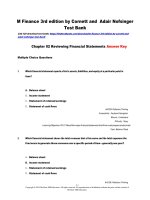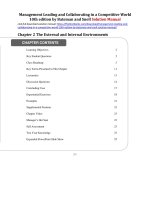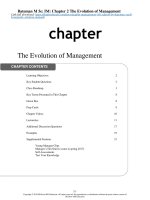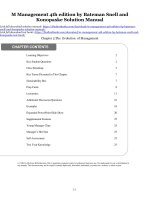M management 3rd edition by bateman and snell test bank
Bạn đang xem bản rút gọn của tài liệu. Xem và tải ngay bản đầy đủ của tài liệu tại đây (1.17 MB, 222 trang )
M Management 3rd edition by Bateman and Snell Test Bank
Link full download solution manual: />Link full download test bank: />
Chapter 02
The Evolution of Management
True / False Questions
1.
In the context of the origins of management, Wu Qi, a Chinese general, discussed the
importance of planning and leading in his book The Art of War.
True False
2.
Around AD 1436, the Sumerians standardized production through the use of an assembly
line, building warehouses and using an inventory system to monitor the contents.
True False
3.
In the context of the origins of management, throughout history, most managers operated by a
trial-and-error basis.
True False
4.
In the context of the origins of management, the emergence of the Hawthorne Effect
drove managers to strive for further growth.
True False
2-1
© 2013 by McGraw-Hill Education. This is proprietary material solely for authorized instructor use. Not authorized for sale or distribution in any
manner. This document may not be copied, scanned, duplicated, forwarded, distributed, or posted on a website, in whole or part.
5.
The opportunities for mass production created by the industrial revolution spawned intense
and systematic thought about management problems and issues.
True False
6.
Toward the end of the industrial revolution, bureaucracy emerged as a formal
discipline. True False
7.
The evolution of management thought is divided into two major sections: classical approaches
and contemporary approaches.
True False
8.
In the context of the classical approaches to management, the systematic management
approach led to widespread production efficiency.
True False
9.
Scientific management emphasized internal operations because managers were
concerned primarily with meeting the explosive growth in demand brought about by the
industrial revolution.
True False
10. Adam Smith introduced the scientific management approach in response to the failure
of systematic management to bring about widespread production efficiency.
True False
2-2
© 2013 by McGraw-Hill Education. This is proprietary material solely for authorized instructor use. Not authorized for sale or distribution in any
manner. This document may not be copied, scanned, duplicated, forwarded, distributed, or posted on a website, in whole or part.
11. In the context of scientific management, a key element of Frederick Taylor’s approach was the
principle of esprit de corps, that refers to promoting a unity of interests between employees and
management.
True False
12. In the context of scientific management, Lillian Gilbreth focused on the human side
of management and was interested in how job satisfaction motivated employees.
True False
13. According to Max Weber, bureaucratic positions foster specialized skills, eliminating
many subjective judgments by managers.
True False
14. One of the fourteen principles of management identified by Henri Fayol was the subordination
of individual interest to the general interest.
True False
15. In the context of the human relations approach to management, Abraham Maslow argued that
people try to satisfy their lower-level needs and then progress upward to the higher-level needs.
True False
16. The human relations approach to management ignored the more rational side of the worker and
the important characteristics of the formal organization.
True False
2-3
© 2013 by McGraw-Hill Education. This is proprietary material solely for authorized instructor use. Not authorized for sale or distribution in any
manner. This document may not be copied, scanned, duplicated, forwarded, distributed, or posted on a website, in whole or part.
17. In the context of contemporary approaches to management, sociotechnical systems theory helps
a manager make a decision by developing formal mathematical models of the problem.
True False
18. In the context of contemporary approaches to management, research on sociotechnical
systems theory was a precursor to the total quality management (TQM) movement.
True False
19. In the context of contemporary approaches to management, managers do not rely on
the methods of quantitative management as the primary approach to decision making.
True False
20. In the context of contemporary approaches to management, many aspects of a
management decision cannot be expressed through mathematical symbols and formulas.
True False
21. In the context of Douglas McGregor’s Theory X and Theory Y, an important implication for
managers who subscribe to Theory X subscribe to Theory X is known as a contingency.
True False
22. According to the contingency perspective, there is only “one best way” to manage and organize.
True False
2-4
© 2013 by McGraw-Hill Education. This is proprietary material solely for authorized instructor use. Not authorized for sale or distribution in any
manner. This document may not be copied, scanned, duplicated, forwarded, distributed, or posted on a website, in whole or part.
23. Understanding contingencies helps a manager know which sets of circumstances dictate
which management actions.
True False
24. In the context of modern contributors, Jim Collins discovered that “level 5 leaders” often
leave enduring legacies without drawing a lot of attention to themselves.
True False
25. Peter Drucker, a respected management guru, was the first person to discuss “management by
objective” (MBO), by which a manager should be self-driven to accomplish key goals that link
to organizational success.
True False
26. The book In Search of Excellence discussed how a leader’s success hinges on balancing
between personal and professional effectiveness.
True False
27. Christopher A. Bartlett championed several ideas that continue to be influential to this day,
including decentralization, employees as assets, corporation as a human community, and
the importance of knowledge workers in the new information economy.
True False
28. Peter Senge of MIT Sloan School of Management founded the “Society of
Organizational Learning.”
True False
2-5
© 2013 by McGraw-Hill Education. This is proprietary material solely for authorized instructor use. Not authorized for sale or distribution in any
manner. This document may not be copied, scanned, duplicated, forwarded, distributed, or posted on a website, in whole or part.
29. If one does not anticipate change and adapt to it, one’s firm will not thrive in a
competitive business world.
True False
30. Change continually creates both new opportunities and new demands for lowering costs and
for achieving greater innovation, quality, and speed.
True False
Multiple Choice Questions
31. In 1776, _____ discussed control and the principle of specialization with regard to
manufacturing workers.
A. Douglas McGregor
B. Max Weber
C. Frederick Taylor
D. Abraham Maslow
E. Adam Smith
2-6
© 2013 by McGraw-Hill Education. This is proprietary material solely for authorized instructor use. Not authorized for sale or distribution in any
manner. This document may not be copied, scanned, duplicated, forwarded, distributed, or posted on a website, in whole or part.
32. _____ refer(s) to reductions in the average cost of a unit of production as the total
volume produces increases.
A. Sociotechnical systems
B. Bureaucracy
C. Systematic management
D. Economies of scale
E. Quantitative management
33. _____, one of the first university programs to offer management and business education,
was founded in the late 19th century.
A. Harvard Business School at Harvard University
B. The Wharton School at the University of Pennsylvania
C. Stanford Graduate School of Business at Stanford University
D. MIT Sloan School of Management at the Massachusetts Institute of Technology
E. Kellogg School of Management at Northwestern University
34. _____ is a classical management approach that attempted to build into operations the specific
procedures and processes that would ensure coordination of effort to achieve established
goals and plans.
A. Scientific management
B. Administrative management
C. Systematic management
D. Human relations
E. Bureaucracy
2-7
© 2013 by McGraw-Hill Education. This is proprietary material solely for authorized instructor use. Not authorized for sale or distribution in any
manner. This document may not be copied, scanned, duplicated, forwarded, distributed, or posted on a website, in whole or part.
35. _____ introduced the scientific management approach that advocated the application of scientific
methods to analyze work and to determine how to complete production tasks efficiently.
A. Frederick Taylor
B. Henry L. Gantt
C. Lillian M. Gilbreth
D. Max Weber
E. Henri Fayol
36. In the context of scientific management, which of the following is true of Frederick
Taylor’s contributions?
A. Taylor believed that supervisors would be motivated to provide training to
underperforming workers.
B. Taylor created the Gantt chart, which helps managers plan projects by task and time
to complete those tasks.
C. Taylor developed a system to lower costs and increase worker productivity by showing how
employees could work smarter, not harder.
D. Taylor eventually focused less on the technical and more on the human side of management.
E. Taylor advocated the use of the differential piecerate system.
37. In the context of scientific management, critics claimed that:
A. organizations that need rapid decision making and flexibility may suffer with this approach.
B. managers may ignore appropriate rules and regulations.
C. managers were not trained to apply the principles of the theory.
D. too much authority may be vested in too few people.
E. it did not help managers deal with broader external issues such as government regulations.
2-8
© 2013 by McGraw-Hill Education. This is proprietary material solely for authorized instructor use. Not authorized for sale or distribution in any
manner. This document may not be copied, scanned, duplicated, forwarded, distributed, or posted on a website, in whole or part.
38. In the context of classical approaches to management, _____ believed bureaucratic structures can
eliminate the variability that results when managers in the same organization have different
skills, experiences, and goals.
A. Peter Drucker
B. Henri Fayol
C. Mary Follett
D. Lillian Gilbreth
E. Max Weber
39. Which of the following is a drawback of the bureaucratic approach to management?
A. Production tasks were reduced to machine-like movements that led to boredom.
B. The approach did not help managers deal with competitors and government regulations.
C. Some people did not perform their best with excessive rules and regulations.
D. The approach emphasized only money as a worker incentive.
E. Management decisions were unsystematic.
40. In the context of Henri Fayol’s 14 principles of management, _____ refers to promoting a unity of
interests between employees and management.
A. initiative
B. esprit de corps
C. centralization
D. subordination
E. stability
2-9
© 2013 by McGraw-Hill Education. This is proprietary material solely for authorized instructor use. Not authorized for sale or distribution in any
manner. This document may not be copied, scanned, duplicated, forwarded, distributed, or posted on a website, in whole or part.
41. In the context of administrative management, _____ wrote the book Dynamic Administration,
which emphasized the continually changing situations that managers face.
A. Lillian Gilbreth
B. Adam Smith
C. Henri Fayol
D. Max Weber
E. Mary Parker Follett
42. Which of the following is one of Henri Fayol’s 14 principles of management?
A. Qualifications
B. Ownership
C. Rules and controls
D. Scalar chain
E. Adaptation
43. Which of the following is one of the five functions of management as identified by Henri Fayol?
A. Commanding
B. Adapting
C. Rewarding
D. Recognizing
E. Advancing
2-10
© 2013 by McGraw-Hill Education. This is proprietary material solely for authorized instructor use. Not authorized for sale or distribution in any
manner. This document may not be copied, scanned, duplicated, forwarded, distributed, or posted on a website, in whole or part.
44. Who contributed two key principles—the notion that managers desire flexibility and the
differences between motivating groups and individuals—to administrative management?
A. Lillian Gilbreth
B. Chester Barnard
C. Mary Parker Follett
D. Henri Fayol
E. Frederick Taylor
45. In the context of classical approaches to management, the _____ approach aimed at understanding how
psychological and social processes interact with the work situation to influence performance.
A. scientific management
B. systematic management
C. administrative management
D. human relations
E. bureaucracy
46. The _____ were a series of experiments conducted from 1924 to 1932 to investigate the influence
of physical working conditions on workers’ productivity and efficiency.
A. Michigan Leadership Studies
B. Johari Window
C. Hawthorne Studies
D. Forming-Storming Model
E. Hierarchy of Needs
2-11
© 2013 by McGraw-Hill Education. This is proprietary material solely for authorized instructor use. Not authorized for sale or distribution in any
manner. This document may not be copied, scanned, duplicated, forwarded, distributed, or posted on a website, in whole or part.
47. In the context of the human relations approach to management, after conducting the four
stages of the _____, Mayo and his team eventually concluded that productivity and employee
behavior were influenced by the informal work group.
A. Hawthorne Studies
B. Michigan Leadership Studies
C. Blake and Mouton Managerial Grid
D. Johari Window
E. Novelty Studies
48. In the context of classical approaches to management, proponents of the ____ approach argued that
managers should stress primarily employee welfare, motivation, and communication.
A. scientific management
B. systematic management
C. human relations
D. administrative management
E. bureaucracy
49. In the context of classical approaches to management, which of the following is a principle of
the human relations approach?
A. Scientific methods should be applied to analyze work.
B. Social needs have precedence over economic needs.
C. Management should cooperate with workers to ensure that jobs match plans.
D. Wasteful movements can be identified and removed to increase productivity.
E. Management is a profession and can be taught.
2-12
© 2013 by McGraw-Hill Education. This is proprietary material solely for authorized instructor use. Not authorized for sale or distribution in any
manner. This document may not be copied, scanned, duplicated, forwarded, distributed, or posted on a website, in whole or part.
50. Which classical approach to management advocates that management must gain the
cooperation of the group and promote job satisfaction and group norms consistent with the
goals of the organization?
A. Systematic management
B. Scientific management
C. Bureaucracy
D. Administrative management
E. Human relations
51. Which of the following is true of Abraham Maslow’s contribution to the field of human relations?
A. He emphasized maintenance of inventories to meet consumer demand.
B. He was concerned with meeting the explosive growth in demand brought about by
the industrial revolution.
C. He suggested that humans have five levels of needs.
D. He concluded that management decisions were unsystematic.
E. He advocated the application of scientific methods to analyze work.
52. According to Abraham Maslow, the most advanced human need is for:
A. esteem.
B. love or belonging.
C. self-actualization.
D. safety.
E. the body.
2-13
© 2013 by McGraw-Hill Education. This is proprietary material solely for authorized instructor use. Not authorized for sale or distribution in any
manner. This document may not be copied, scanned, duplicated, forwarded, distributed, or posted on a website, in whole or part.









